Pl. Mitskevycha – monument to Adam Mickiewicz
The monument to the national Polish poet was opened on 30 October 1904. Its construction was carried out from late 1903 under the supervision of Alfred Zachariewicz and Józef Sosnowski. The author of the project, who won an architectural competition, was Antoni Popiel, a famous sculptor. Earlier, there was a figure of the Virgin Mary on its place.
Architecture
The monument is made in the form of a composite order column, with a high granite pedestal on which the bronze statue of Adam Mickiewicz is installed. A figure of a winged genius, handling the poet a lyre, is attached to the column. On top of the capital, there is a "burning" lantern. Metal letters on the front of the pedestal bear the inscription Adam Mickiewicz; in the rear, there is a large bronze cartouche with the coats of arms of Lithuania and Poland.
The monument is placed in the middle of an island in the form of a trapezoid with rounded corners. Wide stairs with low sandstone balustrades lead to it on two sides. On the sides, there are symmetrical grass plots with dwarf bushes around the perimeter. The monument is made of Milan granite and bronze.
Personalities
Ernest Bandrowski — the vice-president of the city of Krakow, a representative of the
official Krakow delegation at the opening of the monument.
Władysław Belza — a member of the Adam Mickiewicz Literary Society in Lviv.
Wilhelm Bruchnalski — a member of the Adam Mickiewicz Literary Society in Lviv.
Ludwik Cwikliński — a member of the committee for the construction of the monument.
Jan Kanty Federowicz — the vice-president of the city of Krakow, a representative of the
official Krakow delegation at the opening of the monument.
Ludwik Finkel — a member of the Adam Mickiewicz Literary Society in Lviv.
Cyprian Godebski — a famous Polish sculptor who worked in Paris, a member of the jury
of the contest for the monument project.
Agenor Gołuchowski — the governor of Galicia in 1866-1868, 1871-1875.
Zygmunt Gorgolewski — a famous Lviv architect, a member of the jury of the contest for the
monument project.
Władysław Gubrynowicz — the owner of a bookstore who was well-known in Lviv.
Juliusz Hochberger — the chief architect of Lviv, a member of the jury of the contest for
the monument project.
Jan Höflinger — the owner of a famous confectionery factory in Lviv.
Józef Kallenbach — a member of the Adam Mickiewicz Literary Society in Lviv.
Adam Krechowiecki —a well-known Lviv journalist, a member of the
Adam Mickiewicz Literary Society in Lviv and the Committee for the construction
of the monument.
Roman Lewandowski — a member of the jury of the contest for the monument project.
Juliusz Leo — the president of the city of Krakow, a representative of the
official Krakow delegation at the opening of the monument.
Władysław Łoziński — a famous Lviv historian of arts, a collector and public figure, the
chairman of the Committee for the preparation of the celebration of Adam Mickiewicz's centennial birth.
Julian Makarewicz — a famous Lviv artist, a member of the jury of the contest for the
monument project.
Władysław Mickiewicz — the poet's son, a participant of the opening ceremony.
Stanisław Wierusz
Niemojowski — the owner of a paper mill in
Lviv.
Kazimierz Peplowski — the second treasurer of the Committee.
Roman Pilat — the head of the Adam Mickiewicz Literary Society in Lviv, a member
of the committee for the construction of the monument.
Tadeusz Pini — the secretary of the Committee for the preparation of the celebration of Adam Mickiewicz's centennial birth.
Wiktorya Schimser — the owner of a company.
Henryk Schmitt — a Polish historian who supported the autonomy of Poland, one of the
activists who called for the establishment of a monument to Mickiewicz.
Ludwik Skrzyński — a co-author of the first appeal to the governor of Galicia containing
the idea of installing the monument to Mickiewicz in 1856.
Józef Sosnowski — an architect, one of the managers of the construction works.
Teodor Srpek — the owner of a Viennese factory which cast the bronze figures of the
monument.
Edward Stanicki — a count, a co-author of the first appeal to the governor of Galicia containing
the idea of installing the monument to Mickiewicz in 1856.
Jan Styka — a renowned Polish artist, a member of the jury of the contest
for the monument project.
Wacław Szymanowski — a Polish carver and artist who lived and worked in Paris.
Teodor Talowski — a well-known Polish architect from Krakow who worked for some time
in Lviv and, together with Antoni Popiel, designed a project to arrange the
area around the monument in 1906.
Pius Weloński — a member of the jury of the contest for the monument project.
Piotr Wojtowicz — a famous Lviv sculptor, a member of the jury of the contest for the
monument project.
Leon Mieczysław Zawiejski — a Polish artist and carver
who lived and worked in the USA and Italy.
Alfred Zachariewicz — an architect, one of the managers of the construction works.
Julian Zachariewicz — a renowned Lviv architect, a member of the jury of the contest
for the monument project.
Kazimierz Zieliński — the Committee treasurer.
Sources
2. ДАЛО 3/1/ 4277;
3. Центральний державний історичний архів України у Львові (ЦДІАЛ) 58/1/1;
4. ЦДІАЛ 58/1/5;
5. ЦДІАЛ 58/1/7;
6. "Pomniki Mickiewicza", Czasopismo techniczne, 1899, 19-20, 30-31
7. "Na pomnik Adama Mickiewicza we Lwowie…", Gazeta Lwowska, 1898, №251, 3;
8. "Pomnik Mickiewicza", Gazeta Lwowska, 1904, №16, 3;
9. "Pomnik Mickiewicza", Gazeta Lwowska, 1904, №24, 3;
10. "Papier Mickiewiczowski", Gazeta Lwowska, 1904, №48, 4;
11. "Wielki koncert Mickiewiczowski", Gazeta Lwowska, 1904, №56, 4;
12. "Na pomnik Mickiewicza…", Gazeta Lwowska, 1904, №71, 3;
13. "Na rzecz pomnika Mickiewicza we Lwowie", Gazeta Lwowska, 1904, №81, 3;
14. "Papier Mickiewiczowski", Gazeta Lwowska, 1904, №90, 3;
15. "Papier Mickiewiczowski", Gazeta Lwowska, 1904, №98, 3;
16. "Na rzecz kolumny Mickiewicza", Gazeta Lwowska, 1904, №102, 3;
17. "Budowa kolumny Miczkiewicza", Gazeta Lwowska, 1904, №133, 4;
18. "Kolumna Mickiewicza we Lwowie", Gazeta Lwowska, 1904, №138, 3;
19. "Kolumna Mickiewicza", Gazeta Lwowska, 1904, №144, 4;
20. "Kolumna Mickiewicza", Gazeta Lwowska, 1904, №151, 3;
21. "Pomnik Mickiewicza", Gazeta Lwowska, 1904, №209, 4;
22. "Pomnik Mickiewicza", Gazeta Lwowska, 1904, №212, 5;
23. "Pomnik Mickiewicza", Gazeta Lwowska, 1904, №216, 4;
24. "Statua Matki Boskiej", "Pomnik Mickiewicza", Gazeta Lwowska, 1904, №221, 3;
25. "Odsłonięcie kolumny Mickiewicza", "Na pomnik Mickiewicza", Gazeta Lwowska, 1904, №229, 3-4;
26. "Postać Mickiewicza", "Koncert Mickiewiczowski", "W biurze pomnikowem...", "Na pomnik Mickiewicza", Gazeta Lwowska, 1904, №234, 3;
27. "Pomnik Mickiewicza", "Na odlew geniusza", Gazeta Lwowska, 1904, №235, 3;
28. "Pomnik Mickiewicza", "Czekolada Mickiewiczowska", Gazeta Lwowska, 1904, №238, 2-3;
29. "Pomnik Mickiewicza", Gazeta Lwowska, 1904, №239, 3;
30. "Pomnik Mickiewicza", "Portrety Mickiewicza", Gazeta Lwowska, 1904, №240, 3-4;
31. "Pomnik Mickiewicza", "Ostatnie posiedzenie...", "Zaproszenie na uroczystość...", Gazeta Lwowska, 1904, №244, 3-4;
32. "P. Władysław Mickiewicz...", "Pomnik Mickiewicza", "Związek...", "Czytelnia katolicka...", "Wydział Gwiazdy...", Gazeta Lwowska, 1904, №248, 3-4;
33. Michał Rolle, "Kolumna Adama Mickiewicza we Lwowie", Gazeta Lwowska, 1904, №250, 2-4;
34. Michał Rolle, "Kronika budowy kolumny Adama Mickiewicza we Lwowie (dokończenie)", Gazeta Lwowska, 1904, №251, 3;
35. "Na pomnik Mickiewicza…", Gazeta Lwowska, 1904, №271, 3;
36. "Koncert ludowy ku czci Mickiewicza", Kurjer Lwowski, 1904, №295, 2;
37. "Odsłonięcie pomnika Mickiewicza","Odezwa do wszystkich ziomków z powodu odsłonięcia pomnika Mickiewicza",Kurjer Lwowski, 1904, №300, 2-3;
38. "Lwów 30 X 1904",Kurjer Lwowski, 1904, №302, 1-5;
39. "Sprawa pomnika Mickiewicza we Lwowie w r. 1856", Kurjer Lwowski, 1904, №317, 2
40. Adam Bieńkowski, "Kronika mickiewiczowska", Rok Mickiewiczowski: Księga pamiątkowa (Lwów: Nakładem księgarni H. Altenberga, 1899), 703;
41. Aleksander Semkowicz, "Kult Mickiewicza we Lwowie", Studia Lwowskie, (Lwów, 1932), 351-366
42. Jurij Smirnow, Stuletni jubileusz pomnika Adama Mickiewicza we Lwowie, (Lwów, 2005), 31
43. Ігор Сьомочкін, "Пам'ятник Міцкевича у Львові", Галицька Брама, №9 (33), 1997
44. Ігор Сьомочкін, " Площа Міцкевича", Галицька Брама, №9 (33), 1997
45. Пам'ятник Міцкевичу у Львові перевірять рентгеном, ZIK, 2006
Edited by Olha Zarechnyuk.
Media Archive Materials
Related Pictures
-
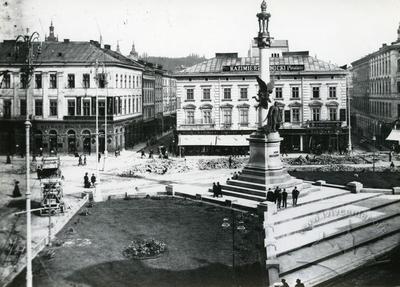 Впорядкування площі навколо пам'ятника Міцкевичу
Впорядкування площі навколо пам'ятника Міцкевичу
-
 Панорама центральних площ міста
Панорама центральних площ міста
-
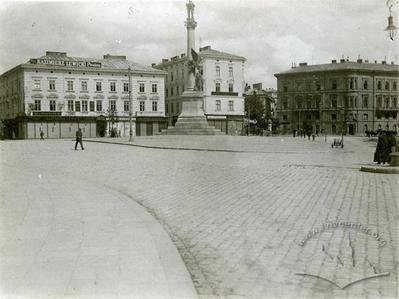 Площа Міцкевича
Площа Міцкевича
-
 Кінний трамвай перед пам'ятником А. Міцкевичу на площі Маріацькій
Кінний трамвай перед пам'ятником А. Міцкевичу на площі Маріацькій
-
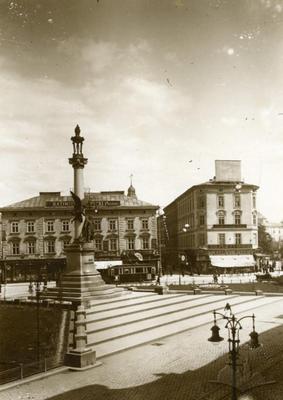 Пам'ятник Адаму Міцкевичу
Пам'ятник Адаму Міцкевичу
-
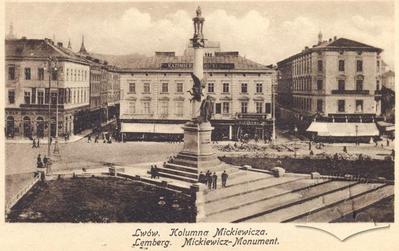 Колона Міцкевича
Колона Міцкевича
-
 Зимовий вид пам'ятника Адаму Міцкевичу
Зимовий вид пам'ятника Адаму Міцкевичу
-
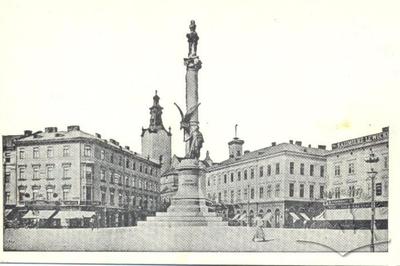 Пам'ятник та площа на честь Міцкевича
Пам'ятник та площа на честь Міцкевича
-
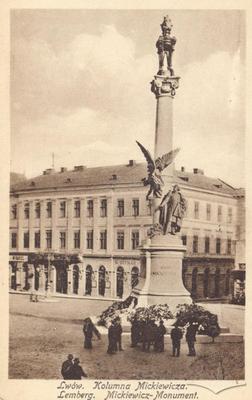 Фронтальний вид пам'ятник Адаму Міцкевичу
Фронтальний вид пам'ятник Адаму Міцкевичу
-
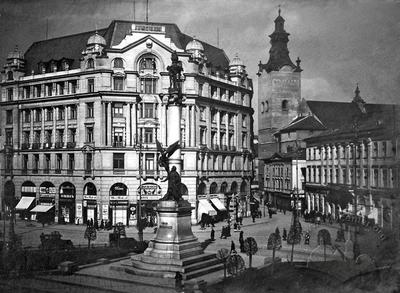 Пам'ятник Адаму Міцкевичу на тлі будинку Шпрехера
Пам'ятник Адаму Міцкевичу на тлі будинку Шпрехера
-
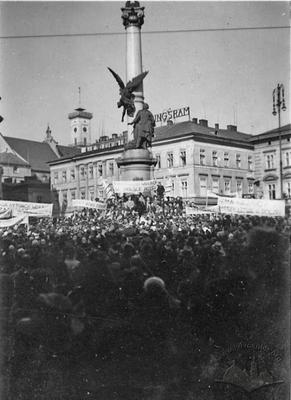 Політична маніфестація на площі Міцкевича
Політична маніфестація на площі Міцкевича
-
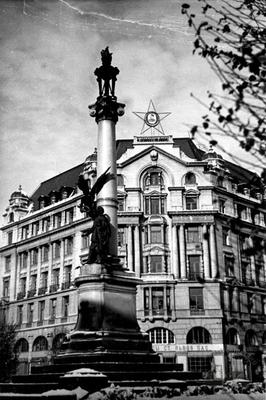 Колона Адама Міцкевича та давній будинок Шпрехера
Колона Адама Міцкевича та давній будинок Шпрехера
-
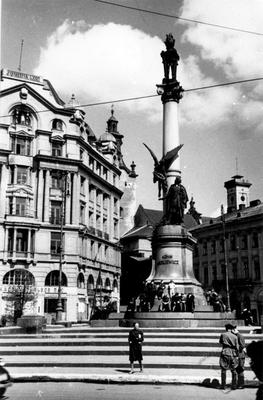 Біля пам'ятника Адаму Міцкевичу
Біля пам'ятника Адаму Міцкевичу
-
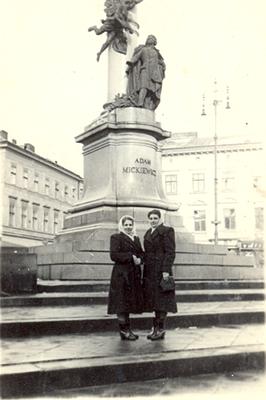 Фото на пам'ять біля пам'ятника Адаму Міцкевичу
Фото на пам'ять біля пам'ятника Адаму Міцкевичу
-
 Виступ хорового колективу біля пам'ятника Адаму Міцкевичу
Виступ хорового колективу біля пам'ятника Адаму Міцкевичу
-
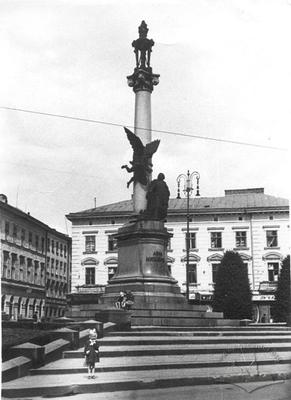 Пам'ятник Адаму Міцкевичу
Пам'ятник Адаму Міцкевичу
-
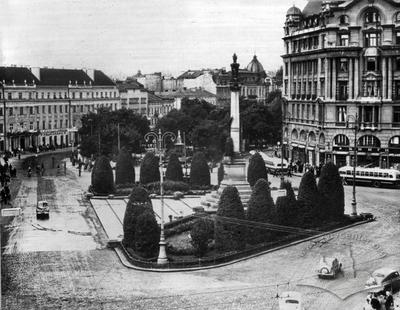 Транспорт на площі Міцкевича
Транспорт на площі Міцкевича
-
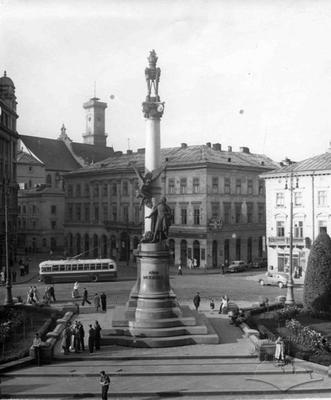 Пам'ятник А. Міцкевичу
Пам'ятник А. Міцкевичу
-
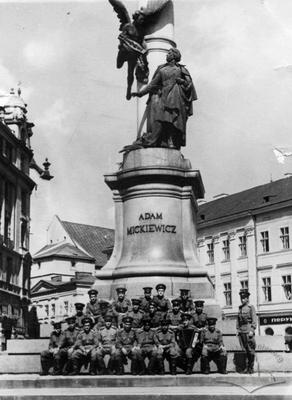 Група радянських військових біля пам'ятника Міцкевичу
Група радянських військових біля пам'ятника Міцкевичу
-
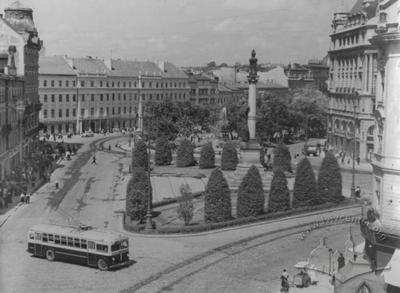 Площа Міцкевича
Площа Міцкевича
-
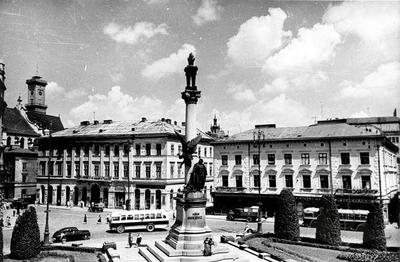 Пам'ятник Адаму Міцкевичу
Пам'ятник Адаму Міцкевичу
-
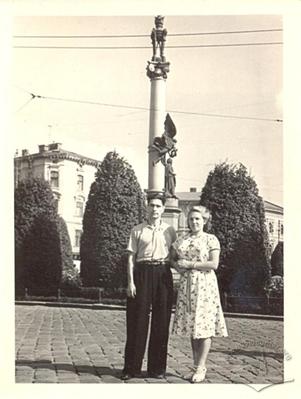 Молода пара біля пам'ятника Адаму Міцкевичу
Молода пара біля пам'ятника Адаму Міцкевичу
-
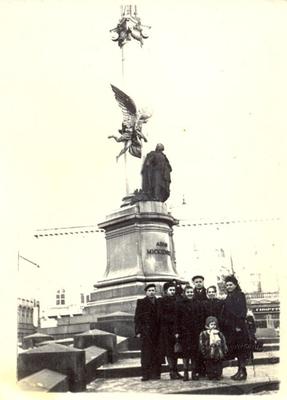 Львівська родина біля пам'ятника Адаму Міцкевичу
Львівська родина біля пам'ятника Адаму Міцкевичу
-
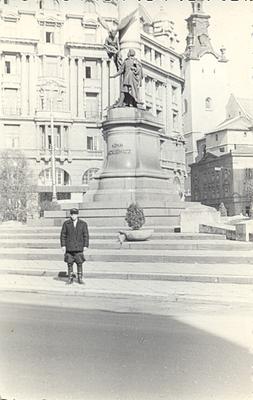 Гість міста біля пам'ятника Міцкевичу
Гість міста біля пам'ятника Міцкевичу
-
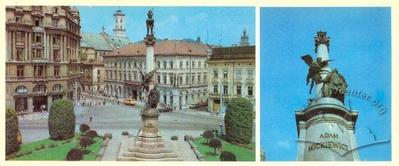 Пам'ятник Адаму Міцкевичу
Пам'ятник Адаму Міцкевичу
-
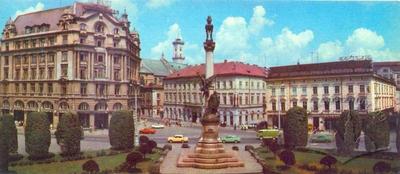 Пам'ятник Адаму Міцкевичу
Пам'ятник Адаму Міцкевичу
-
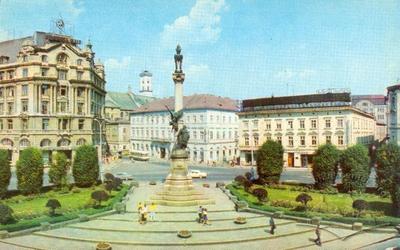 Пам'ятник Адаму Міцкевичу
Пам'ятник Адаму Міцкевичу
-
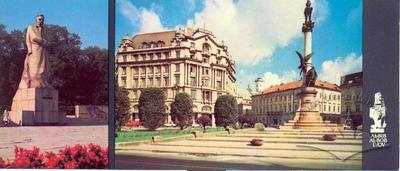 Пам'ятник Міцкевичу та Франку
Пам'ятник Міцкевичу та Франку
-
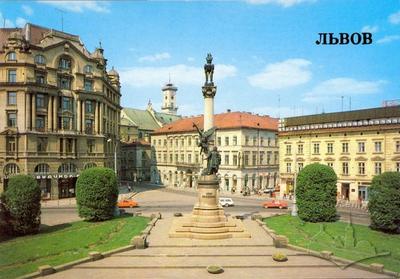 Пам'ятник Адаму Міцкевичу
Пам'ятник Адаму Міцкевичу
-
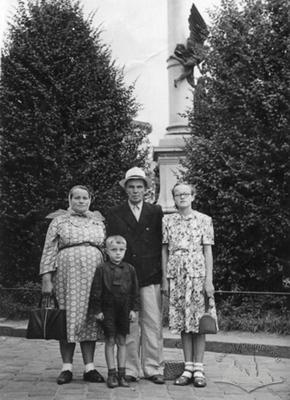 Сім'я біля пам'ятника Міцкевичу
Сім'я біля пам'ятника Міцкевичу
-
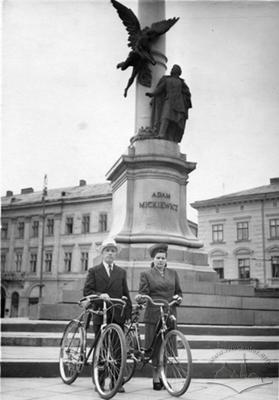 Фото з велопрогулянки
Фото з велопрогулянки















